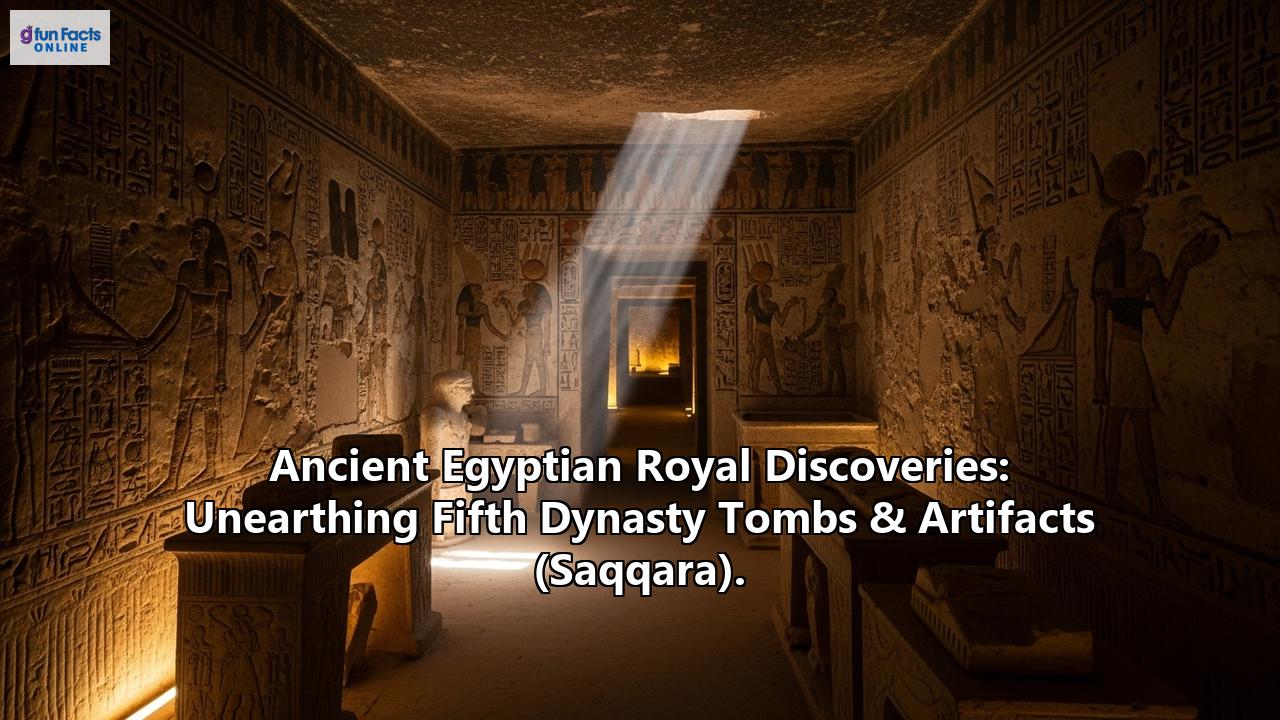The sands of Saqqara, the sprawling necropolis of ancient Memphis, continue to surrender secrets that rewrite chapters of Egyptian history. This hallowed ground, home to the iconic Step Pyramid of Djoser, has once again become the stage for breathtaking revelations, with recent archaeological efforts unearthing a treasure trove of tombs and artifacts, particularly shining a light on the enigmatic Fifth Dynasty (circa 2494–2345 BCE). These discoveries offer an intimate glimpse into the lives, rituals, and power structures of Egypt's Old Kingdom.
A Prince's Lost Tomb Emerges: The Discovery of Waser-If-ReOne of the most electrifying recent finds is the tomb of Prince Waser-If-Re, a previously little-known son of King Userkaf, the founder of Egypt's Fifth Dynasty. Unearthed by an Egyptian archaeological mission, a collaboration between the Supreme Council of Antiquities and the Zahi Hawass Foundation for Archaeology and Heritage, led by the renowned Egyptologist Dr. Zahi Hawass, this discovery provides a rare window into royal life approximately 4,500 years ago.
The tomb itself is a testament to the prince's status. Its most striking feature is a monumental false door crafted from pink granite, standing an imposing 4.5 meters tall and 1.15 meters wide – the largest of its kind ever discovered in Egypt. False doors were a common feature in ancient Egyptian tombs, believed to allow the deceased's soul to pass between the world of the living and the dead. The sheer size and material of Waser-If-Re's false door underscore his importance. Intricate hieroglyphs adorn the door, meticulously listing the prince's many titles, including “Hereditary Prince,” “Royal Scribe,” “Vizier,” “Judge,” “Governor of Buto and Nekheb,” and “Chanting Priest.”
Further exploration of the tomb complex revealed a second entrance on its eastern side, bearing inscriptions with the prince's name and, significantly, a cartouche of King Neferirkare, another Fifth Dynasty ruler. This, along with other findings, indicates a fascinating history of reuse. Evidence suggests the tomb, originally constructed during the Old Kingdom, was repurposed centuries later during Egypt's 26th Dynasty (Late Period, 688–525 B.C.).
Artifacts That Speak VolumesInside the tomb, archaeologists were greeted by a stunning array of artifacts. Among the most dramatic are thirteen pink granite statues seated on high-backed chairs. It's believed some of these figures represent the prince's wives, though intriguingly, some are headless. Nearby, an overturned black granite figure, 1.35 meters tall, was found, adding to the mystique.
A red granite offering table, nearly a meter in diameter and inscribed with a detailed list of ritual offerings, provides insight into the funerary rites performed for the prince. Supporting the theory of the tomb's later reuse is a black granite statue of a standing male figure, measuring 1.17 meters, whose name and titles are carved into it. This statue is believed to date to the 26th Dynasty.
Perhaps one of the most surprising discoveries within Prince Waser-If-Re's final resting place was a statue ensemble of King Djoser (Third Dynasty), accompanied by his wife and ten daughters. Preliminary analysis suggests these statues were originally housed in a chamber near Djoser's Step Pyramid and were relocated to Waser-If-Re's tomb during the Late Period. The reasons behind this significant move remain a subject of ongoing investigation, adding another layer of intrigue to the Saqqara narrative.
Saqqara: A Continuing Source of Fifth Dynasty KnowledgeThe discovery of Prince Waser-If-Re's tomb is the latest in a series of significant Fifth Dynasty finds at Saqqara. In January 2023, archaeologists unveiled other tombs from this era, including one belonging to a priest named Khnumdjedef, and another to an official named Meri, who held the title "keeper of the secrets." These finds, dating back roughly 4,300 to 4,500 years, also included statues, amulets, and a well-preserved sarcophagus containing a mummy covered in gold leaf.
Earlier, in 2019, the tomb of a Fifth Dynasty dignitary named Khuwy was discovered in south Saqqara. This excavation also led to the identification of a previously unknown queen from the late Fifth Dynasty, Setibhor, whose name was found engraved on a granite column within her pyramid complex. Her funerary temple was noted for its large size and incorporation of architectural elements usually reserved for kings.
The Enduring Legacy of SaqqaraSaqqara's importance as a necropolis for Memphis, the ancient capital, cannot be overstated. It served as a burial ground for royalty and high officials across numerous dynasties, and its sands are a rich tapestry of Egyptian history. Each new discovery, like that of Prince Waser-If-Re's tomb and its associated artifacts, brings archaeologists closer to understanding the complexities of ancient Egyptian civilization, its rulers, religious beliefs, and artistic achievements.
Excavations are ongoing, with teams hopeful of uncovering further chambers and artifacts that will shed more light on the Fifth Dynasty and the later periods of Saqqara's use. Renowned Egyptologist Dr. Zahi Hawass has even hinted that 2025 could be a landmark year for archaeological revelations in Egypt, potentially answering long-standing questions about its ancient past. The unearthing of these Fifth Dynasty tombs and artifacts at Saqqara not only enriches our knowledge but also underscores the enduring allure of ancient Egypt and the thrill of discovering its hidden wonders.
Reference:
- https://www.npr.org/2023/01/27/1151958356/egypt-unveils-tombs-and-a-sarcophagus-in-a-new-excavation
- https://www.newsweek.com/arachaeologists-ancient-egyptian-tomb-saqqara-false-door-2070886
- https://en.wikipedia.org/wiki/Saqqara
- https://archaeologymag.com/2025/04/tomb-of-prince-waser-if-re-in-saqqara/
- https://www.ancient-origins.net/news-history-archaeology-ancient-places-africa/fifth-dynasty-egyptian-prince-0022041
- https://arkeonews.net/the-tomb-of-prince-with-a-monumental-pink-granite-false-door-unearthed-in-saqqara/
- https://english.news.cn/africa/20250419/1e8a2910fc7c4099976c247c31f8ac2d/c.html
- https://egyptianstreets.com/2025/04/19/ancient-tomb-of-fifth-dynasty-prince-unearthed-in-saqqara/
- https://english.ahram.org.eg/NewsContent/9/40/544833/Antiquities/Ancient-Egypt/Tomb-of-prince-WaserIfRe-unearthed-in-Saqqara.aspx
- https://www.livescience.com/archaeology/ancient-egyptians/tomb-of-ancient-egyptian-prince-discovered-at-saqqara-and-it-has-a-giant-false-pink-door
- https://archaeology.org/news/2025/04/21/egyptian-princes-tomb-uncovered-at-saqqara/
- https://www.dailynewsegypt.com/2025/05/06/2025-landmark-year-for-egyptian-archaeology/
- https://popular-archaeology.com/article/discoveries-in-the-shadow-of-the-step-pyramid-2/
- https://www.archaeology.wiki/blog/2019/04/03/fifth-dynasty-tomb-and-name-of-a-new-queen-discovered-at-saqqara/
- https://english.ahram.org.eg/News/329288.aspx

